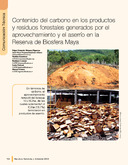| dc.contributor.author | Bámaca Figueroa, E.E. | |
| dc.contributor.author | Kanninen, M. | |
| dc.contributor.author | Louman, B. | |
| dc.contributor.author | Pedroni, L. | |
| dc.contributor.author | Gómez, M. | |
| dc.date.accessioned | 2020-10-26T22:46:30Z | |
| dc.date.available | 2020-10-26T22:46:30Z | |
| dc.date.issued | 2004-03 | |
| dc.identifier.issn | e-ISSN: 1021-0164 | ISSN |
| dc.identifier.uri | https://repositorio.catie.ac.cr/handle/11554/9784 | |
| dc.description | 9 páginas, 8 ilustraciones, 1 tabulaciones, 20 referencias. | |
| dc.description.abstract | La importancia del carbono en los residuos de los procesos de aprovechamiento y aserrío fue evaluada mediante un estudio en la unidad de manejo Río Chanchich, Petén, Guatemala en el 2002. Para un total de 57 árboles -el 4,5 porciento de los árboles aprovechados- se estimó el volumen de madera y la biomasa dañada por la caída de cada árbol. La biomasa removida por la apertura de caminos y patios de acopio se estimó a partir del tamaño de las áreas abiertas. En el aserradero se estimó el volumen útil y de residuos de 95 trozas. El volumen promedio por árbol aprovechado fue de 6,24 m3 y solamente el 53,3 porciento de la madera llegó al aserrío, el resto quedó como residuos en el bosque. Del volumen de las trozas aserradas, un 87 por ciento correspondió a madera, el rendimiento del aserrío fue de 51,2 porciento del volumen sin corteza, utilizando un aserradero port{hooka}til. En términos de carbono, el aprovechamiento removió del bosque 10,2 tC/ha, de las cuales solamente 1,4 tC/ha (13,7 por ciento) terminaron en productos. | |
| dc.description.abstract | Carbon content in wood residues was evaluated in the forest management unit Rio Chanchich, Petén, Guatemala. Wood volume per individual and the biomass damaged by felling of each tree were estimated for 57 trees (4,5 percent of the trees cut). Biomass eliminated by road and stockyard construction was estimated according to size of the cleared area. Useful volume and residues from 95 wood logs were estimated at the sawmill. Average volume per individual was 6,24 m 3 . Only 53,3 percent of the wood arrived at the sawmill while the rest remained as residues in the forest. From that amount, 87 percent was timber milling efficiency was 51,2 percent, using a portable sawmill. In terms to carbon, logging removed 10,2 tC/ha from the forest, but only 1,4 tC/ha (13,7 percent) ended up in wood products. | |
| dc.language.iso | es | es_ES |
| dc.publisher | CATIE, Turrialba (Costa Rica) | |
| dc.relation.isformatof | Recursos Naturales y Ambiente Número 41 (Marzo 2004), páginas 102-110 | |
| dc.relation.ispartof | Recursos Naturales y Ambiente Número 41 (Marzo 2004) | |
| dc.rights | info:eu-repo/semantics/openAccess | |
| dc.subject | APROVECHAMIENTO DE LA MADERA | |
| dc.subject | VOLUMEN | |
| dc.subject | ASERRADO | |
| dc.subject | BIOMASA | |
| dc.subject | MODELOS MATEMATICOS | |
| dc.subject | RESIDUOS DE EXPLOTACION FORESTAL | |
| dc.subject | DIOXIDO DE CARBONO | |
| dc.subject | CARBONO | |
| dc.subject | EFECTO INVERNADERO | |
| dc.subject | RESERVAS NATURALES | |
| dc.subject | GUATEMALA | |
| dc.title | Contenido del carbono en los productos y residuos forestales generados por el aprovechamiento y el aserrío en la Reserva de Biosfera Maya | es_ES |
| dc.title.alternative | Carbon content of forest products and residues generated by timber harvesting and sawmilling in the Mayan Biosphere Reserve | es_ES |
| dc.type | Artículo | es_ES |


